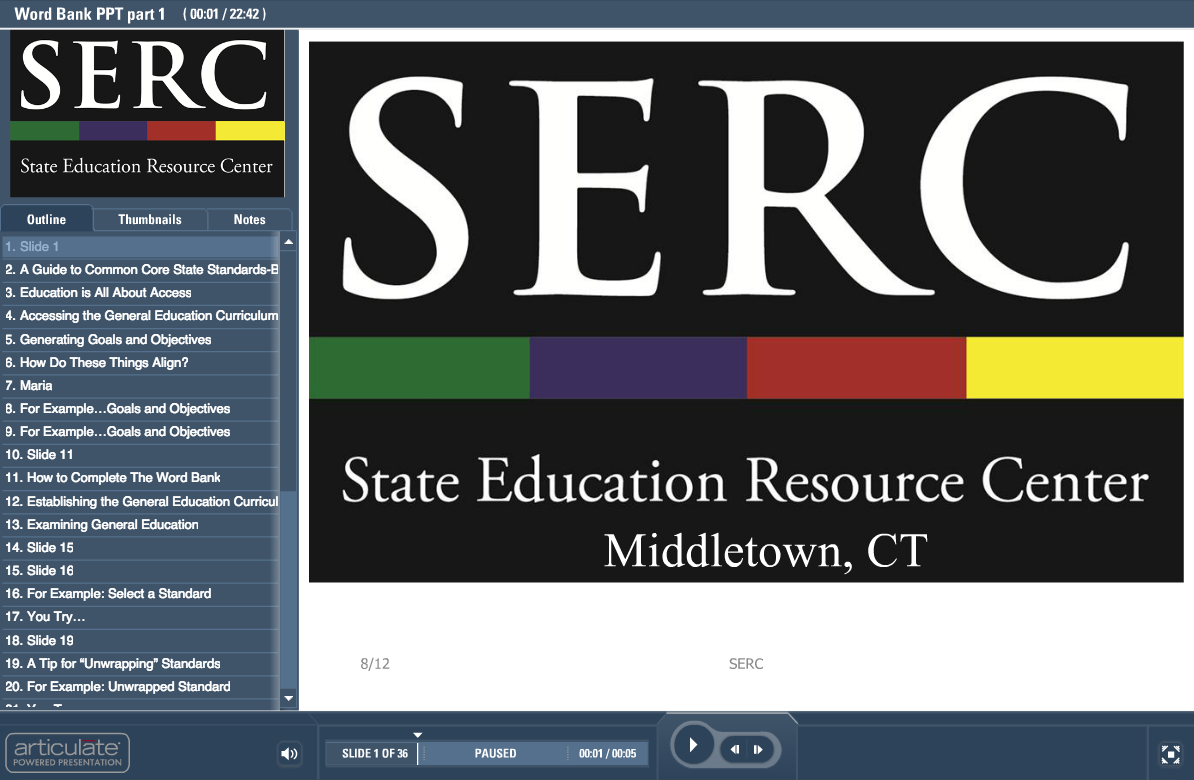Directions for the Tutorials
This presentation provides instruction on a tool that promotes the design of standards-based IEP goals and objectives. This presentation can be used for individual, small group, or full staff professional development. The training is broken up into three separate parts that are sectioned into components intended to be used sequentially. Each module contains hands-on opportunities to apply the skills taught in the presentation. The three parts can be viewed in either a single sitting or over several sittings. If you choose to view them in a single sitting, the total recommended time for viewing the presentations and the completion of the hands-on activities is 3 hours. If you choose to view them in more than one sitting, it is recommended that you plan to complete at least one part in its entirety within a sitting. It is also recommended that each sitting occurs reasonably close in time to maintain the flow and continuity of the learning. E.g., Part 1 is viewed on Monday; parts 2 and 3 are viewed on Tuesday. Listed below are the recommended times for each part.
- Part 1: 1 ½ hours
- Part 2: ½ hour
- Part 3: 1 hour
Before Using This Tutorial:
- Select a specific student to use as a case study
- Obtain a copy of the district curriculum or Common Core State Standards frameworks in any subject area, matching the grade level of the selected student
- Obtain a copy of the student’s IEP
- Download the tool here
Tips for Selecting a Case Study:
- Determine if a single student case study should be used across all groups or if multiple cases should be used
- Select cases that relate to the grade levels of the participants
- Select cases that represent the typical scenarios in your district (i.e., use a “Goldilocks” rule: not too easy, not too hard)
- Consider using students who have attended the school or district in which the participants are employed
- Consider having participants volunteer to select their own cases
- Remember to respect confidentiality and the integrity of the IEP process; change names of students ahead of time and inform participants that all programming changes for any student must be done through the IEP process outside of this training
Suggstions for Group Use:
- Planning Ahead
- Select facilitators for the session relative to the size of the total audience
- Preview the tutorials ahead of time to assist in the organization and planning
- Plan sufficient time for viewing, completing the activities, and discussing learning
- If viewing over multiple sessions, plan each sitting close in time, e.g. over three consecutive days
- Provide participant learning objectives or a purpose for the training, along with a brief description of Word Bank and how the training will be organized prior to the session
- Copy all materials needed ahead of time
- Determine if CEUs will be offered through your district
-
Organizing Participants and Space
- Consider the size of the group carefully, relative to space available and number of facilitators; this training has been done for up to 50 participants at a time
- Organize participants in teams of 2 to 5 prior to the session and have each team work together
- Use a comfortable space and seating for adults with sufficient room for the facilitators to be able to roam
- Viewing Using a Computer Lab
- Pre-load or set up each computer with the tutorials prior to the session
- Determine how the session will be paced across the groups
- Use only pairs or trios for participant groupings
- Provide directions and timing to the whole group and then allow groups to work at their own pace
- Facilitators should roam to assist the groups
- Viewing Whole Group
- Have an LCD projector and a screen to project the modules to allow for simultaneous viewing
- Have an adequate sound system to allow for everyone to hear comfortably
- Group participants in small teams of 3 to 5
- Arrange the room with multiple tables with 3 to 5 chairs around each table
- Have one main facilitator lead the directions and pacing
- Have other facilitators roam to assist the groups
- Alternative Ways to View
- Study Groups
- Pre-set groups of 3 to 5 participants to work together
- Provide either a set timeframe for completion within which participants can schedule viewing times on their own or establish scheduled blocks of time that participants can use to view
- Determine locations and arrangement for viewing; locations can be spread out
- Multiple Small Groups in Different Locations at the Same Time
- Assign a facilitator to lead each group
- Provide the facilitators with directions and a preview prior to the session
- Provide a set location, materials, and viewing arrangements for each small group
- Provide a set starting and ending time
- Have one or more facilitators roam across the multiple groups and locations during the scheduled sessions
- Study Groups
Standards-Based IEPs Webinar: May 8, 2015
Using the content from the "Developing Standards-based IEP" modules (see above), this hands-on demonstration covered how to access the word bank module and establish professional learning communities aimed at aligning IEPs to the CT Core Standards.
Presenters: Bill Bannish & Stephen Proffitt, Educational Consultants, SERC


